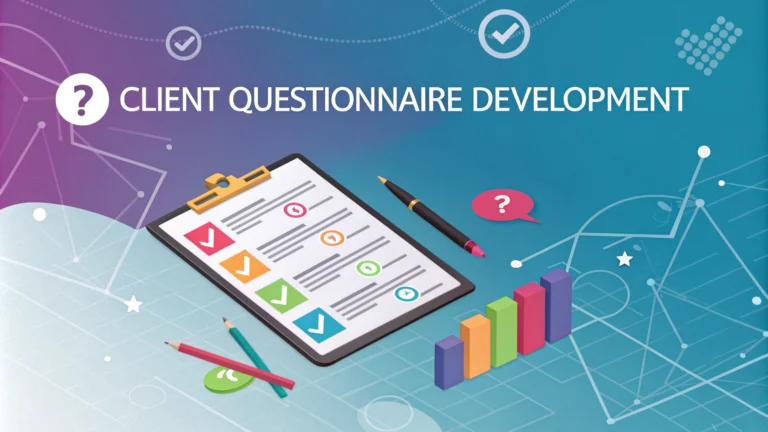A well-structured client questionnaire forms the backbone of successful logo design projects, helping designers understand brand values, preferences, and objectives.
This guide outlines the essential questions to ask clients before starting their logo design project.
Basic Company Information
- Company name and industry
- Products or services offered
- Target audience demographics
- Current branding elements (if any)
Brand Personality Questions
- What are your company’s core values?
- How would you describe your brand’s personality? (Professional, playful, luxurious, etc.)
- What emotions should your logo evoke?
- Who are your main competitors?
Design Preferences
- Color preferences or existing brand colors
- Typography style preferences
- Symbol or icon preferences
- Preferred logo style (minimalist, abstract, illustrative)
Technical Requirements
- Where will the logo be used? (Print, digital, signage)
- Required file formats
- Size requirements
- Application examples (business cards, website, social media)
Project Details
- Budget range
- Timeline expectations
- Number of concept options needed
- Revision process preferences
Sample Questions Format
| Category | Question Example |
|---|---|
| Brand Values | “What three words best describe your company?” |
| Visual Style | “Do you prefer symbolic or typographic logos?” |
| Competition | “Which competitor logos do you admire or dislike?” |
Tips for Better Responses
- Use open-ended questions to encourage detailed responses
- Include visual examples where applicable
- Request specific examples rather than general descriptions
- Ask about both likes and dislikes
- Include questions about future growth and scalability
Consider using online tools like Google Forms or Typeform to create professional-looking questionnaires.
Keep the questionnaire focused and limit it to 15-20 key questions to maintain client engagement.
Red Flags to Watch For
- Vague or inconsistent responses
- Unrealistic expectations
- Conflicting design preferences
- Lack of clear business objectives
Remember to follow up with clients if answers need clarification or seem contradictory.
Additional Design Considerations
- Cultural implications and sensitivities
- International usage requirements
- Industry-specific regulations
- Long-term brand evolution possibilities
Client Communication Strategy
- Schedule initial consultation meeting
- Document all communication
- Set clear milestone expectations
- Establish feedback channels
Common Communication Challenges
- Misaligned expectations
- Subjective feedback
- Technical terminology barriers
- Timeline misunderstandings
Questionnaire Implementation
- Send questionnaire before initial meeting
- Review responses thoroughly
- Prepare follow-up questions
- Create project brief based on responses
Conclusion
A comprehensive logo design questionnaire serves as a crucial foundation for successful branding projects. By gathering detailed information about the client’s business, preferences, and requirements, designers can create meaningful and effective logo designs that align with the client’s vision and objectives.
Regular refinement of the questionnaire based on project experiences and client feedback helps maintain its effectiveness and relevance. Remember that the questionnaire is a starting point for an ongoing dialogue between designer and client throughout the logo design process.
| Success Metrics | Key Benefits |
|---|---|
| Clear project scope | Reduced revision cycles |
| Detailed client insights | Better design alignment |
| Documented requirements | Improved project efficiency |
FAQs
- How much does professional logo design typically cost?
Professional logo design can range from $300 to $2500+ for small businesses, while enterprise-level logo design can cost $10,000 or more. The price varies based on designer experience, complexity, and deliverables included. - What file formats should I receive with my final logo design?
You should receive vector files (AI, EPS, SVG), raster files (JPEG, PNG), and PDF formats. Vector files are essential for scalability, while raster files are for digital use. You should also get both color and black/white versions. - How long does the logo design process typically take?
A professional logo design process typically takes 2-4 weeks, including research, conceptualization, initial designs, revisions, and final delivery. Complex projects may take longer, especially with multiple stakeholders. - What makes a logo design effective?
An effective logo should be simple, memorable, versatile, appropriate for the industry, and work well in both color and black/white. It must be scalable across different mediums and instantly recognizable at various sizes. - Should I trademark my logo design?
Yes, if your business is established and you want legal protection. Trademark registration prevents others from using similar designs and gives you exclusive rights to your logo in your industry and geographic area. - What information does a designer need to create my logo?
Designers need your business name, industry, target audience, preferred colors, competitor analysis, brand values, and intended logo applications. They also need to know your style preferences and any specific symbols or elements to include or avoid. - Can I use my logo design on any medium?
Yes, if properly designed in vector format, your logo can be used across all mediums: digital (websites, social media), print (business cards, brochures), merchandise, signage, and more. - How many concepts should I expect to see during the design process?
Typically, designers present 3-5 initial concepts. After selecting one direction, you’ll receive 2-3 rounds of revisions to refine the chosen concept into the final design. - What’s the difference between a logo wordmark and a symbol?
A wordmark is a text-only logo design using typography (like Coca-Cola), while a symbol is an icon or graphic mark (like Apple’s apple). Some logos combine both elements in what’s called a combination mark. - How can I ensure my logo design is unique?
Designers should conduct thorough research including trademark searches, competitor analysis, and industry trends. They should also create original artwork rather than using stock graphics or templates.







